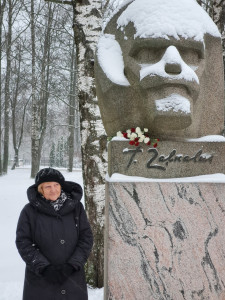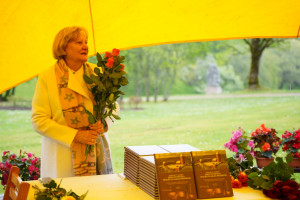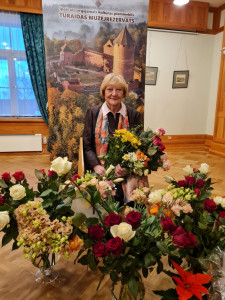At the end of 2021, the monthly magazine "Siguldas Avīze" invited Anna Jurkāne, the founder and long-time director of the Turaida Museum Reserve, for a conversation. The interview was published in the January 2022 issue of "Siguldas Avīze".
30 November 2021 was the last working day for the Director of the Turaida Museum Reserve, Anna Jurkāne. Anna Jurkāne expressed her sincere gratitude to all those who have contributed to the preservation of the Historical Centre of Turaida and the development of the Museum Reserve during her 49 years of work. THANK YOU, THANK YOU... was said so often on this day, talking about what she has done and being with her team. The wish of Anna Jurkāne: "May the strength and resilience of Turaida be an inspiration to all!" www.turaida-muzejs.lv
Looking back, what was it like being the Director of the Turaida Museum Reserve in this period?
This period was different and diverse. To lead a cultural institution for so many years means continuous creativity and progress towards the museum’s development. Yes, it was not just a job, but my whole life for 49 years, with the support of my team and my family. I started working in Turaida in January 1973, when the museum had only a few employees. Gradually the team grew, archaeological investigations of the Turaida Castle were started together with the outstanding archaeologist Jānis Graudonis, restoration of the castle together with architect Gunārs Jansons and restorers, continuous historical research work together with museum specialists and collections were supplemented with historical evidences. Also, setting up new permanent exhibitions together with artists, temporary exhibitions, events, conferences, and so on, including daily work, so that Turaida would have something new for visitors to discover and learn, and they can enjoy and feel satisfied with a well-spent day in the museum. In these years, more than 20 million visitors have seen Turaida, and they have got to know the story of Latvia's history, which in turn has been told around the world.
The Turaida Museum Reserve and state support, how did it develop over the years?
Museums in Latvia have never had high salaries. That was the case in Soviet times, and it is still the case today. There is a lot of talk about identity, about creating a sense of belonging to one's country, to one's land, but the real action, and the support for the study of Latvia’s history and preservation of cultural heritage, for promoting Latvian traditions and wisdom of life, is not so brilliant. Our strength was and is cooperation and public support. The Museum Reserve Support Society, as a non-governmental organisation, was the strong voice that sounded next to us when we went to the Saeima, the Cabinet of Ministers, the Ministry of Culture or the Ministry of Finance for negotiations. The basis for all of this is the honest and professional work of museum staff, perseverance every day, always seeing the result to be achieved. A work process may stall for a while, or additional efforts may have to be put in, but in general, it is only by doing that you can get to a result, and then sooner or later there will be state support. This was also the case with the renovation of the House of Corvée Peasants to arrange the magnificent exhibition “On the Way to the State of Latvia. Corvée-peasant. Independent Farmer. Citizen." In the beginning, there was no funding at all.
Was there also a time when you felt safe to continue your work without worry?
The sense of security was created in the last years before the pandemic started, when our revenue was around one million euros a year, thanks to cooperation with foreign tourism companies and tourist visits. Then we were able to organise more free events for local inhabitants, children, conferences, prepare publications, perform restoration of larger monuments and elaborate projects for the development of the Museum Reserve. But most of all, there was a sense of security in having the freedom, after the Soviet years, to express the Museum Reserve's vision in historical research and interpretation, to create content in the exhibitions based on the collection objects and historical knowledge. Yes, along with that came responsibility, the responsibility of the director for everything related to the preservation of cultural heritage, the creation of exhibitions, the preparation of publications and the maintenance of the large area of the Turaida Museum Reserve and the attraction of funding. Was there a time when it was safe to continue the work without worry? Probably not. As the song goes, "It's a long way to true happiness. When there was no shortage of bread but was a shortage of salt...."
The Turaida Museum Reserve and the municipality, what can you say about this cooperation?
We became a state museum by a decision of the Council of Ministers of the LSSR on 4 November 1988. It was the first meeting headed by Vilnis Edvīns Bresis, which marked a turning point in the government's work towards an independent Latvia. The meeting was held from early morning until very late in the evening. The then administration of the Riga district, which was supervising the Sigulda Local History Museum, supported the transition to the status of a state museum and the becoming of the Turaida Museum Reserve. This was the time when Folk Song Hill was being created, and more space was needed to preserve the museum's collection, which could be obtained by taking over the then neglected buildings of the Economic Centre of the Turaida Estate, managed by the scientific research farm "Krimulda". At that time, the Riga District Municipality was not able to support it financially. As a state institution, the Museum Reserve was located within two administrative-territorial boundaries - Sigulda and Krimulda, from the very beginning of the establishment. Now we are in one territory of the Sigulda Region and almost in its centre. The legislation clearly distinguishes between the use of the state and municipal budgets, but there has always been cooperation, and I think there will be cooperation in the future. It all depends on the willingness to understand that the Museum Reserve documents and preserves historical evidence of the history of Latvia and Sigulda Region, of the local people, their history and way of life, traditions, and as a cultural institution of national importance, it does this at a good professional level so that the region and the municipality of the region can be proud of it. Almost all of the employees of the Museum Reserve live in the area of Sigulda Municipality and feel closely connected to this region, its life and cultural events.

Anna Jurkāne at the monument to Teodors Zaļkalns in Sigulda on 30 November 2021. Photographer Agris Tabaks
The Turaida Museum Reserve has become not only a custodian of cultural heritage but also offers educational programmes. Exhibitions, collections and books are available not only on-the-spot but also digitally. How did you manage, moving with the times, to develop this modern offer?
We all live here and now, in this time and space called Sigulda, Latvia, Europe, in this great cultural space. Nowadays, it is hard to do without digital technologies. It facilitates the circulation of information, and it is particularly important in carrying out a computerized inventory of the collections because there are nearly 100 000 units in the Museum Reserve's collection. There is even ancient evidence - rock samples from the Ordovician-Silurian period, 460.9 - 416 million years old.
The museum has good cooperation with many information technology companies, especially in the development of exhibitions. We are happy to see Sigulda-based companies creating interesting and high-quality digital programmes in collaboration with the Museum’s researchers who have developed the content. The museum's digital offer is available in the exhibitions and on our website. In 2021, the website was supplemented with an “e-Turaida” section, where you can explore the Museum's extensive offer remotely from your home computer. There are 13 virtual exhibitions, 21 books, 28 videos, 9 digital programmes, a virtual tour and two digitised antique prints from the Museum's book collection. The electronic catalogue of the Museum's collection with 67 305 descriptions of objects, the number of which is increasingly being replenished, has been modernised this year and is available to visitors remotely. This is the result of many years of work.
A note of patriotism is always present in the work of the Turaida Museum Reserve. In your opinion, how important is it for society to be aware of this above all?
We live in this country, in our own country. It is our home, our security and our responsibility. Who else will take care of it but ourselves? You cannot love what you do not know. The museum's exhibitions are so full of the stories of our great-grandfathers, of the generations before us, of how every trace of this land, every birthplace, every farmstead that has been established and protected with such difficulty, was infinitely important to them. As the folk song says: "On the edge of the field I laid my head, guarding my homeland". To give your life for your land, fight for your land, and defend your land and your country. I think that in society, as in the Museum Reserve, there is this note of patriotism, as you say.
Work team at the Turaida Museum Reserve. What was your approach to making it professional, hard-working and always reliable?
Over the years, the Museum's work has had its ups and downs. In a museum, as in other institutions, everything is determined by the people who work there. We have learnt a lot by attending seminars, conferences, comparing our work with other museums in Latvia and Europe, travelling to exchange experiences. Participating in the European Museum of the Year Award, in 1996, and being recognised as one of the top ten European museums was worth it. I am, really grateful to the many people I have worked with, and I expressed that in my story on my last day as Director to the Museum team. It has always been sad and even painful for me that for various reasons I had to part from a knowledgeable professional. Good museums in the world do not come immediately, simply from a project, just as good exhibitions do not come without research and knowledge, without a collection. A museum is the result of the work of several generations, which is why it is so important that there is heredity, the transfer of knowledge to young professionals. But in everyday life, the team is built on understanding, listening, support, patience, calmness, restraint, etc. Oh, these meetings used to be annoying for many people, including me, but they were not without their benefits, because passing on information and talking is a very important part of the job.
What do you think the last few years of pandemics have taught us?
Yes, this is a time of serious trials and tribulations, when we are each trying to cope with our problems when we are overwhelmed by a sense of helplessness. That is why people always need the support, the shoulder, the love and the kindness of others. The ability to remain calm within oneself and try to accept the way things are and look for a way out of the impasse. If we look back in history, there have been many epidemic periods – “a harvest of death”. The most important thing is to remain human and to support each other so that words are matched with deeds also at the national and local level.
In your opinion, are these difficult times for the Turaida Museum Reserve or have they been even more difficult?
Every change, especially this time of the pandemic, of course, brings instability. I think that the work invested over the years in the preservation of the Historical Centre of Turaida and the developed conceptual vision of the future about the importance of this place and its contribution to the study of Latvia's cultural heritage, identity and history is a safe foundation and a certain guarantee for the long-term existence of the Museum Reserve. At the moment, we have to thank the Ministry of Culture for its support and funding, because our income is not as high as it used to be. The Museum Reserve had a very difficult time during the financial crisis of 2009-2010, with staff reduction, more than 20 employees had to be released, at one time there was no funding at all, and according to the government’s decision the museum had to pay too high rent to the State Joint Stock Company "State Real Estate".
Currently, very good and supportive cooperation has been established with the State Real Estate Company. We have to thank them for this and we hope that together with their support we will be able to implement several major projects in Turaida. Another very stressful time was in 2002 when the Turaida hillfort had landslides, and in the early 1990s, when the newly established Museum Reserve was threatened with liquidation, privatisation of land and buildings - monuments.
The post of Director of the Turaida Museum Reserve is still vacant, even though the competition was launched in the summer. A second call for applications is now open and will close at the end of December. What do you think is the reason for this?
From the outside, it seems that the position and the work of the Director are a piece of cake, entwined by joy, achievements and international success in such a beautiful and historically significant and popular place as Turaida – “The Garden of God". Actually, it is a great, even overwhelming responsibility to preserve, protect and daily maintain one of Latvia's most important and popular cultural centres, the most visited museum in Latvia for years, an internationally-recognized place. To provide investigation and research of the Turaida Castle complex, the Turaida Church Hill, the Economic Centre of the Turaida Estate, the area of Folk Song Hill and monuments, to understand the essence of museum work and that of cultural heritage. To be familiar with more than a thousand years’ history of this area, and to lead the museum team to build and develop this Historic Centre together. After the first competition, I was very disappointed because I had hoped for a good outcome and was ready to support further work if needed. Yes, the salary for the Director is perhaps too low compared to other positions, but the job is also very rewarding.

Anna Jurkāne on 18 May 2021 in Turaida during the celebration of International Museum Day. Photographer Agris Tabaks
Is there someone in your sight whom you would entrust with the management of the Turaida Museum Reserve?
I have to say now, as my great colleague Imants Lancmanis often says, "I rely on Providence". The choice of the new director is not up to me or the staff of the Museum Reserve, it is made in a competition organised by the Ministry of Culture. I very much hope that Turaida will succeed and that the person who is ready to take on this responsibility will truly love this place and work with a great sense of responsibility.
We represent the printed media, which now has to work hard to prove its existence. Thank you, Mrs Jurkāne, you have always supported our publications, both with the preparation of educational materials by the professionals of the Turaida Museum Reserve and financially! The Green New Deal and digitisation are priority axes for society at the European Union level. In your opinion, how can we keep a balance so that, in the pursuit of technical progress, we remember to preserve the core values?
We are all working together, and we want to live in a green, wonderful, healthy, kind and loving world. We want to maintain our Latvian identity, to create a sense of belonging to the place where we live, where we work, which we try to make more interesting by sharing our knowledge and life experience. It all starts with oneself, it is said so often nowadays, and it is probably true.
After so many years of hard work, how will you shape your daily life?
It also happens that those beautiful plans may never come true. As the saying goes, “Man plans and God does”. The past year was very hard for me, for my family. I have lost my husband, with whom I have been married for 51 years, who was my wise and professional advisor also in the conservation of monuments and the maintenance of the infrastructure of the Museum Reserve. The whole family contracted Covid-19, although we were vaccinated. Thanks to Arisa, Anita, Jolanta, my dear daughter Baiba, my grandson Gabriel, my brother Ēvalds, who strengthened me in a difficult time. I hope that I will be able to complete the works started in the Museum Reserve, prepare a publication on the creation of Folk Song Hill, organise the scientific archive and contribute to the sustainability and development of the Museum Reserve as much as possible with my advice. I do not want to live in illusions and build castles in the air, but to find spiritual fulfilment by supplementing and acquiring new knowledge to share with others.
Please share your experience, what advice do you have for others, where to draw strength for the challenges!
As I said, I think that all strength must be found within oneself and in difficult moments, no matter how hard it is, you have to hold on. The joy of doing creates energy and satisfaction, which in turn spurs us on to take the next step to stand up, get involved and find a solution. I wish everyone resilience and wisdom acquired through experience about the great truths and values of life! Happy, blessed and peaceful New Year!
Thank you for your responsiveness!
Ināra Miškina, Monthly magazine "Siguldas Avīze”





